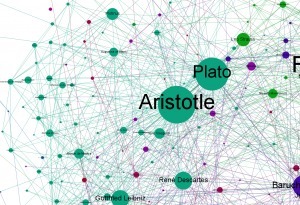Each philosopher is a node in the network and the lines between them (or edges in the terminology of graph theory) represents lines of influence. The node and text are sized according to the number of connections. The algorithm that visualises the graph also tends to put the better connected nodes in the centre of the diagram so we the most influential philosophers, in large text, clustered in the centre. It all seems about right with the major figures in the western philosophical tradition taking the centre stage. (I need to also add the direction of influence with a arrow head – something I’ve not got round to yet.)
A shortcoming however is that this evaluation only takes into account direct lines of influence. Indirect influence via another person in the network does not enter into it. This probably explains why Descartes is smaller than you’d think.
It gets more interesting when we use Gephi to identify communities (or modules) within the network. Roughly speaking it identifies groups of nodes which are more connected with each other than with nodes in other groups. Philosophy has many traditions and schools so a good test would be whether the algorithm picks them out...
Via Martin Daumiller, Lauren Moss



 Your new post is loading...
Your new post is loading...







